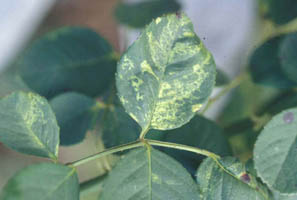Viral Diseases of Plants | |
|---|---|
| June 2, 2008 | |
|
This is a topic that causes much confusion to commercial growers, consultants, and homeowners. As a reminder, viral diseases do not form spores or fruiting bodies as do fungi. They do not produce ooze as do the bacterial pathogens. In fact, they cannot be cultured in a lab because they grow only in living cells. All of these facts make a positive identification of a virus difficult. We rely on symptoms and serological tests to accurately identify virus diseases. Plant viruses are strands of RNA or DNA. Obviously, these strands are too small to be seen by the naked eye. Viruses are placed into plant tissue by insects or vegetative propagation, or they enter through wounds. Virus particles cannot replicate on their own but cause the live plant cell to replicate more viral particles. They usually become systemic within the host plant. An infected plant may be able to co-exist with the virus, or it may be killed. In any event, the plant cannot be cured of the viral infection. Some viral diseases are very host specific, and others are general, over many hosts. Symptoms include stunting, mosaic, ring spots, color breaks, and distortion. Viral diseases are usually easy to distinguish from fungal and bacterial diseases but are often confused with herbicide injury, nutrient stress, and other environmental stress. The pattern of affected plants is often very helpful in distinguishing disease from other causes. Some examples of viruses on annuals and perennials include geranium yellow net, hosta virus X, iris mosaic, impatiens necrotic spot virus (INSV), tomato spotted wilt virus, Ajuga viruses, and cucumber mosaic virus on Aquilegia, Dahlia, Delphinium. The images show rose mosaic virus on rose  and tomato spotted wilt virus on begonia.  So how do you diagnose a viral disease on your plants? First review the possibilities for the host in question. Then look in texts or online for pictures of infected plants of the same host. If you think a virus is involved, consult a lab that can test for viruses. The University of Illinois has immunostrip tests for many common plant viruses and can test those at a cost of $12.50 per virus. Standard ELISA (enzyme-linked immunosorbant assay) testing may be the only test available. The cost for ELISA testing is considerably more. Commercial growers are usually the clients who pursue confirmation of plant virus problems. For more on viral diseases of ornamentals, consult Report on Plant Disease, no. 608 (geraniums), 612 (gladiolus), 614 (orchids), 632 (roses), 634(tulip), 654 (iris), and 665 (tomato spotted wilt). These are available at http://www.ag.uiuc.edu/~vista/rpd.html or at your local University of Illinois Extension office. | |
| Author: | Nancy Pataky |
